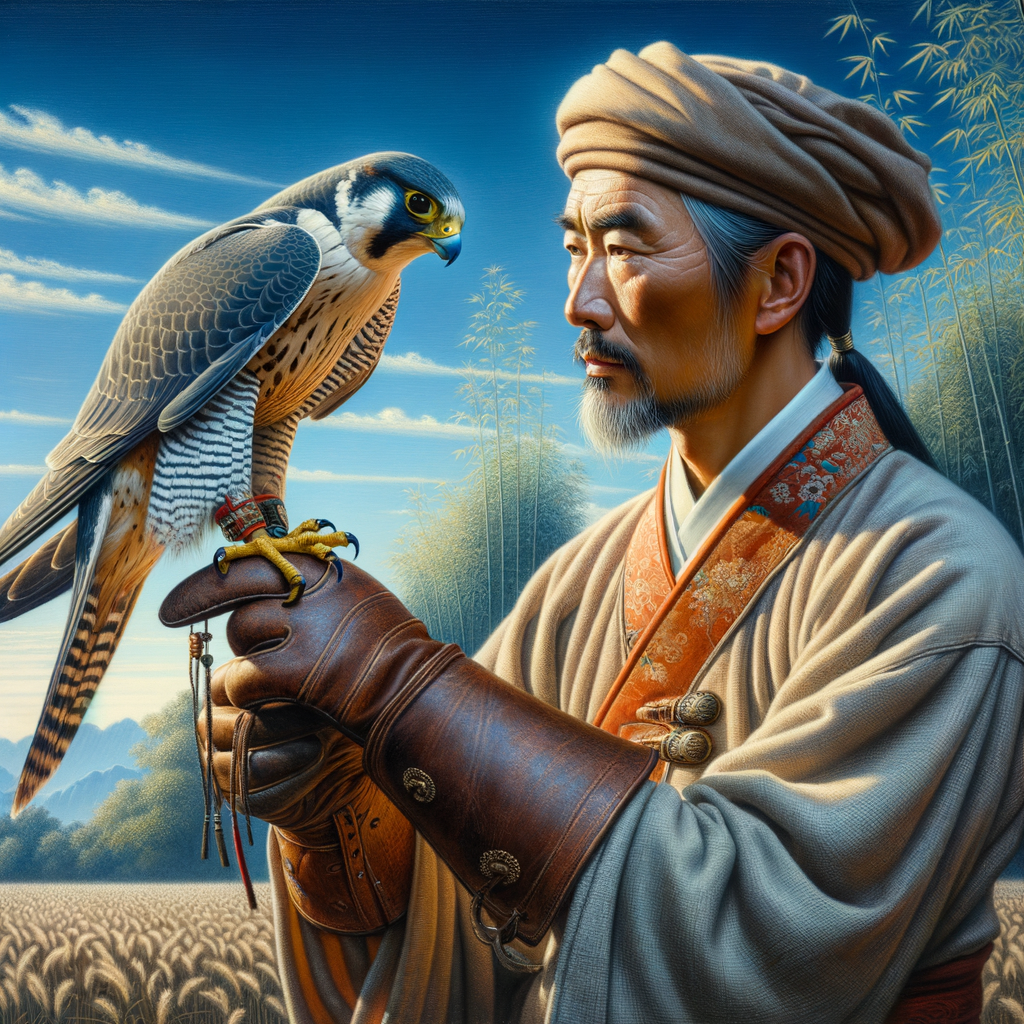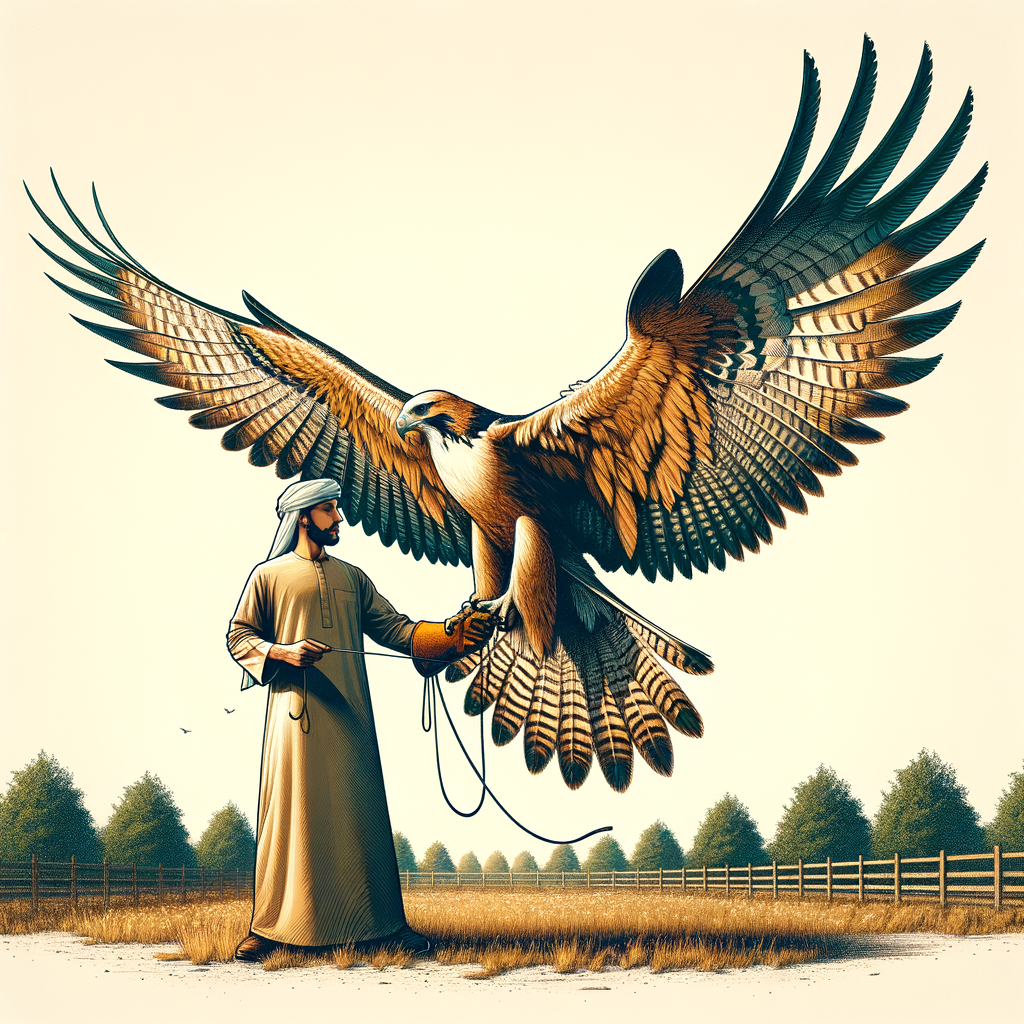Fascinating Intersection of Falconry and Chinese Culture
- Ancient Beginnings: Falconry has roots far back in history and was practiced by royalty in ancient China.
- Cultural Significance: Falconry symbolized power, nobility, and wisdom in Chinese traditions.
- A Noble Pursuit: It was a pastime for emperors and aristocrats, showing their status and skill.
- Art and Literature: Birds of prey often appeared in Chinese paintings, poetry, and stories, reflecting their cultural importance.
- Philosophical Meanings: Falcons were seen as symbols of freedom, diligence, and intelligence in Chinese philosophy.
- Modern Practice: Today, falconry is still practiced and admired, blending tradition with modern techniques.
- Conservation Efforts: Falconry has also evolved to include efforts in wildlife conservation and environmental awareness.
- Connecting with Nature: The practice promotes a deep bond with nature and wildlife, encouraging respect and understanding.
Learn more about how the ancient art of falconry and its intricate ties with Chinese culture continue to resonate even today.
Unraveling the Mystique of Falconry in Chinese Culture
Imagine this: you’re wandering through the lush, emerald-green hills of Ireland, where ancient traditions are whispered on the wind, much like the captivating call of a falcon soaring high above. Just as these Irish legends have been cherished and passed down through generations, so too has the incredible art of falconry in China. Here at Learn Falconry, we believe that understanding these timeless practices connects us more deeply to our shared human history and enriches our modern lives.
Falconry, or the practice of training birds of prey to hunt in collaboration with humans, has been an integral part of Chinese culture for centuries. It’s like stumbling upon an age-old Irish myth that holds layers of wisdom and adventure waiting to be discovered. This article takes you on a fascinating journey through the rich tapestry of Chinese falconry, revealing its significance in the past and its enduring importance today.
Why should you keep reading? Just as the Irish believe in the luck of the leprechaun, exploring the world of Chinese falconry might just bring a bit of magic and wonder into your life. You’ll uncover tales of majestic birds, master falconers, and the unique bond they share ‘ a bond that transcends time and speaks to the very heart of our connection with nature.
Dive in with us and let’s explore the enchanting world of falconry in Chinese culture together ‘ it’s a story that promises to captivate, inspire, and broaden your horizons.
Exploring Chinese Falconry Traditions
Chinese falconry has a rich and fascinating history that dates back over two thousand years. This ancient tradition, known as “YÄ«ng yóu,” which translates to ‘heroic falcon’ or ‘hawk,’ has deep cultural roots in China. Falconry in China is not just a sport or a hunting technique; it is a cultural heritage that reflects the relationship between humans and nature.
The History of Chinese Falconry
Chinese falconry practices began during the Han Dynasty (206 BC ‘ 220 AD) and flourished throughout various dynasties, including the Tang (618’907 AD) and Qing (1644’1912 AD) Dynasties. It was during these times that falconry became more than just a means of hunting; it was an art form, a symbol of nobility, and a method of training the mind and body. Learn more about the ancient origins of falconry here.
Key Practices in Chinese Falconry
Training the Falcons: Training a falcon in China involves intricate methods passed down through generations. Falconers spend years mastering the techniques needed to properly train and care for these remarkable birds of prey. Discover more about training a falcon here.
Falconry Equipment: Essential equipment, such as hoods, gloves, and jesses, is critical for the safety and management of both the falconer and the falcon. Each piece of equipment is tailored to fit the needs of the falcon and ensure successful training sessions. Explore various falconry equipment here.
Falconry in Chinese Culture
In Chinese falconry traditions, the practice is often associated with virtues like patience, respect, and harmony with nature. The tradition emphasizes a deep bond between the falconer and the bird, highlighting the importance of ethical treatment and understanding of these magnificent creatures. Learn more about the ethical aspects of falconry.
Modern Falconry Techniques in China
While preserving traditional methods, modern Chinese falconry has also integrated advancements in technology to aid in training and tracking the birds. GPS trackers and telemetry have become vital tools in ensuring the safety and effectiveness of falconry activities. Read about modern falconry techniques.
Conclusion
With its deep historical roots and continuing evolution, Chinese falconry remains a vibrant and respected tradition. Whether you’re new to falconry or an experienced falconer, understanding Chinese falconry traditions can provide valuable insights into the rich tapestry of this ancient practice. Begin your falconry journey today.
For further information, be sure to check out other related articles on Learn Falconry:
Falconry in Chinese Culture
Falconry has a rich history and is deeply ingrained in Chinese culture. As interest in this traditional practice continues to grow, let’s explore the various aspects of falconry in China, its influences, challenges, and the support it receives.
Government Support since 2007
In 2007, the Chinese government began actively promoting falconry. This support has been crucial for sustaining and expanding the practice:
- Local families involved in falconry receive monthly subsidies ranging from 300 to 600 Yuan (approximately $50-100 USD).
- These subsidies have incentivized more people to engage in falconry, transforming it into an industry.
Raptor Species Used
Several species of raptors are commonly used in Chinese falconry. These include:
- Golden Eagles
- Goshawks
- Sparrowhawks
- Northern Harriers
- Barbary Falcons
- Saker Falcons
Table 1: Raptor Species Used in Chinese Falconry by Ethnic Group
| Ethnic Group | Raptor Species |
|---|---|
| Uygur | Golden Eagle, Goshawk, Sparrowhawk |
| Kirghiz | Golden Eagle, Saker Falcon |
| Manchu | Saker Falcon, Sparrowhawk |
Regional Practices
Falconry traditions vary significantly across different regions in China. For instance:
- Western China: The Uygur and Kirghiz people primarily use Golden Eagles, Goshawks, and Sparrowhawks.
- Jilin Province: The Manchu people, especially in the Falcon Village of Ying Tun, have a long history of falconry that dates back to the Qing Dynasty.
Economic Impact
Falconry can be an additional income source for families:
- Trained falcons can hunt 10 to 20 pheasants per day.
- These pheasants can be sold for up to RMB 150 ($24) each at local markets.
Conservation and Challenges
While falconry holds cultural and economic significance, it also poses certain challenges:
- Population Decline: The Saker Falcon population is declining due to unsustainable capture and other factors.
- Illegal Trapping: An estimated 1,200 Saker Falcons are illegally trapped each year in Qinghai province, adding to the conservation concern.
- Habitat Disturbance: Economic activities, such as mining and oil development, negatively impact breeding grounds for eagles and other raptors.
Chart: Factors Affecting Raptor Populations
| Factors | Impact on Population |
|--------------------------|------------------------|
| Government Subsidies | Positive |
| Illegal Trapping | Negative (Decreasing) |
| Economic Development | Negative (Disturbance) |
| Rodenticide Use | Negative (Prey Loss) |
Falconry Festivals
The Eagle Cultural Festival, held annually in Akqi County, is a significant event:
- Falconers from various regions showcase their skills.
- It serves as an important cultural gathering and helps to keep the tradition alive.
Summary Table: Current State of Falconry
| Aspect | Current Status |
|---|---|
| Government Support | Active since 2007 |
| Common Raptor Species | Golden Eagle, Goshawk, Saker Falcon |
| Regional Practices | Differ across Uygur, Kirghiz, and Manchu |
| Economic Contribution | Up to RMB 150 ($24) per pheasant |
| Conservation Challenges | Population decline, Illegal trapping |
Falconry Villages
- Ying Tun, also known as “Falcon Village”, is a central hub where nearly all the men practice falcon training and hunting, emphasizing the community aspect of the practice.
By understanding these facets, we gain a comprehensive picture of falconry’s role and challenges in Chinese culture today.
Final Thoughts on Falconry in Chinese Culture
Falconry in China is a fascinating tradition that has garnered significant government support since 2007. By offering subsidies, the government has encouraged many families to engage in this practice, turning traditional falconry into an industry. Different raptor species like the Golden Eagle, Goshawk, and Sparrowhawk are used, with specific practices varying among ethnic groups and regions. For instance, the Kirghiz people utilize the Saker Falcon, while the Manchu people have a rich history of falconry dating back to the Qing Dynasty.
However, this rise in popularity has not come without challenges. The Saker Falcon population faces a rapid decline due to unsustainable capture practices, habitat destruction, and other environmental threats. Moreover, economic development such as mining and oil extraction, along with rodent eradication programs, have adversely impacted raptor populations by disturbing habitats and reducing their prey.
Despite these issues, falconry remains an integral part of cultural heritage and a source of income for many families. Annual events like the Eagle Cultural Festival celebrate this tradition, showcasing the skill and dedication of Chinese falconers.
In summary, while falconry in China is thriving and offers economic benefits, it is crucial to address environmental concerns to ensure the sustainability of raptor populations and the preservation of this ancient practice.



